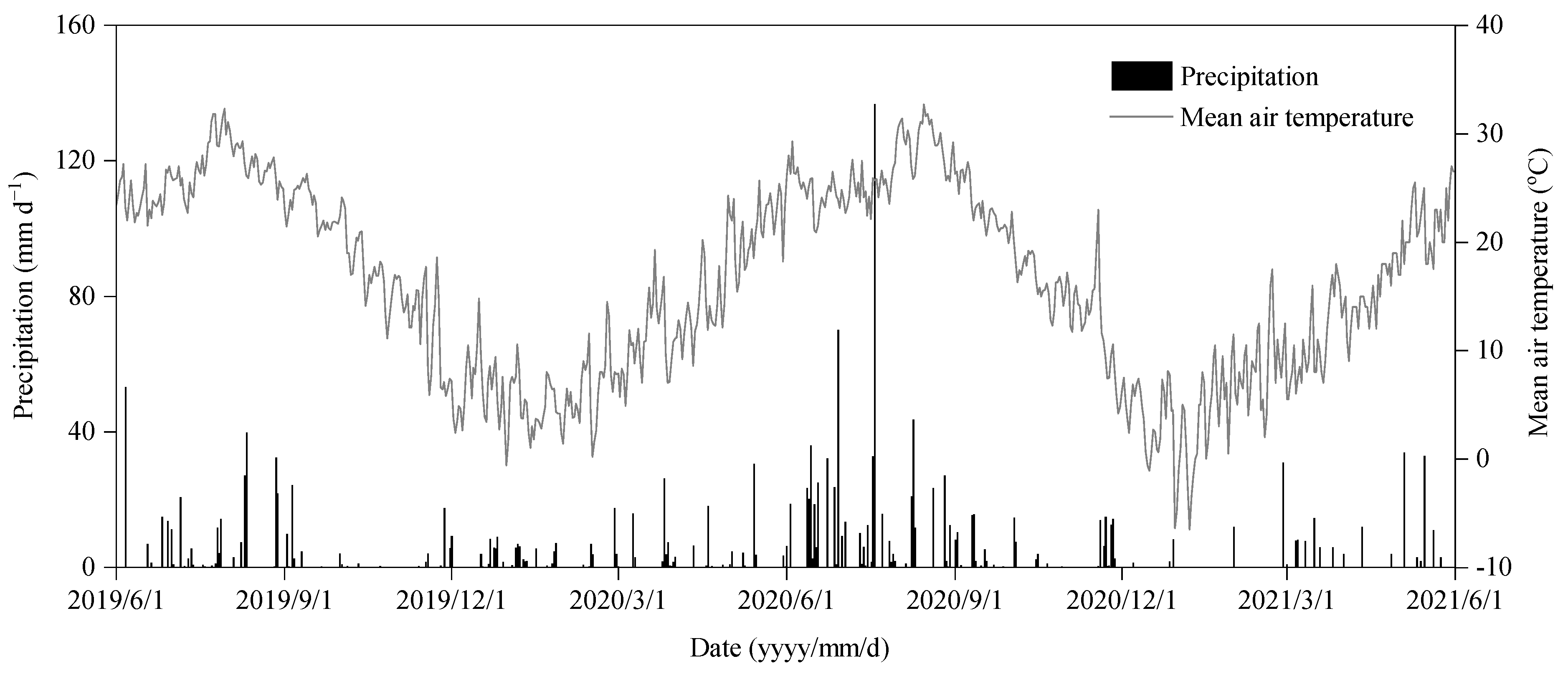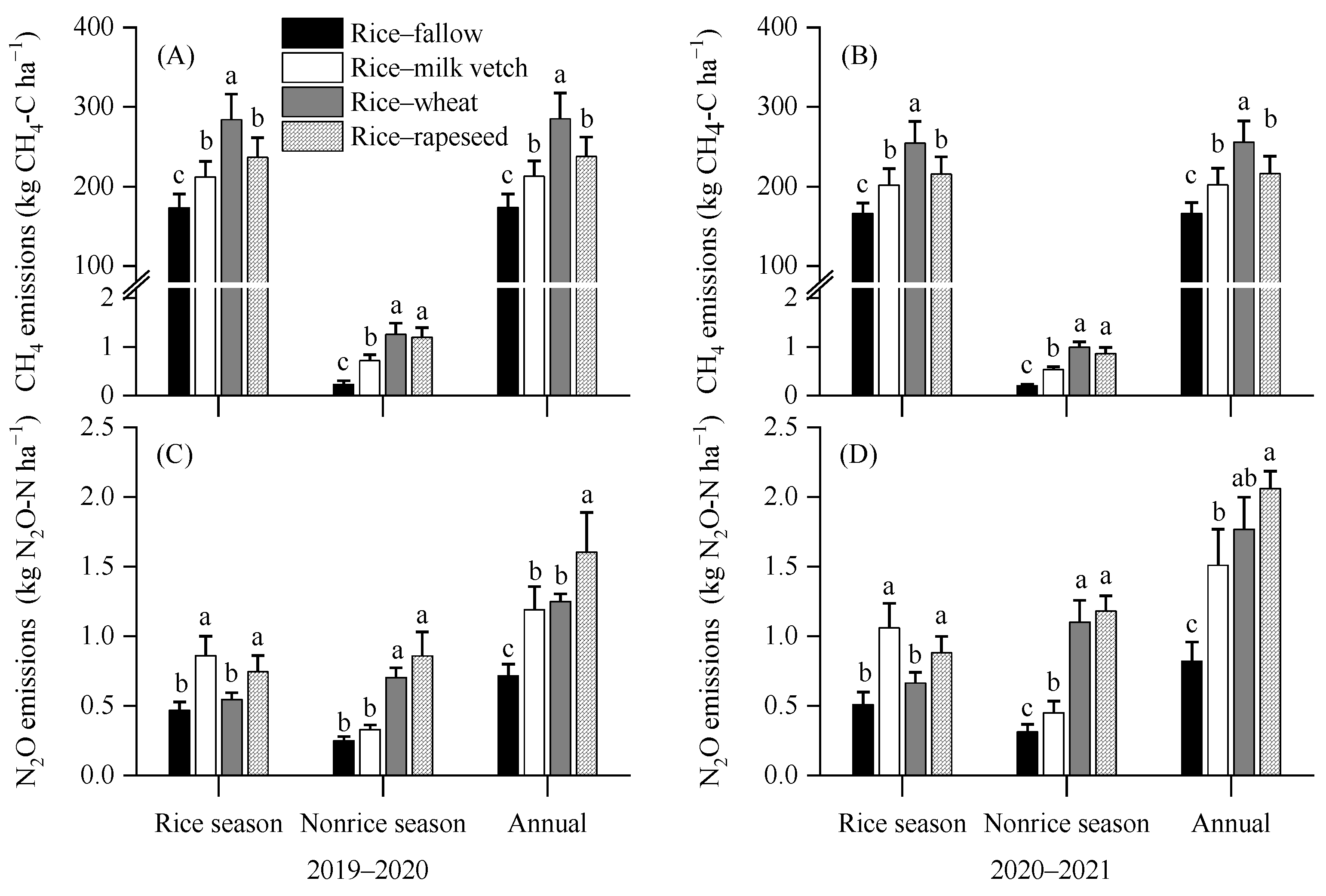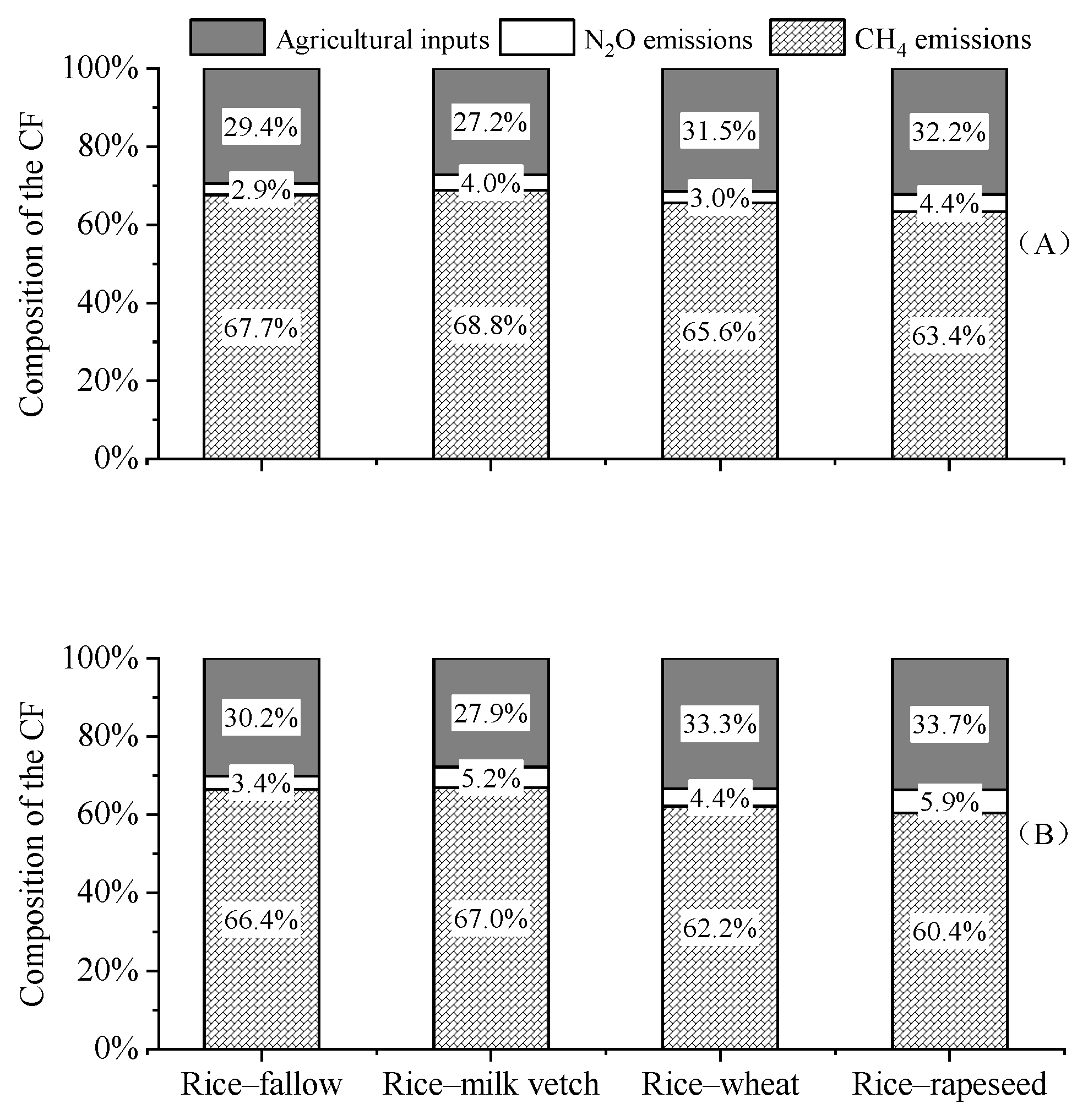Greenhouse Gas Emissions, Carbon Footprint, and Grain Yields of Rice-Based Cropping Systems in Eastern China
Abstract
1. Introduction
2. Materials and Methods
2.1. Experimental Site
2.2. Experimental Details and Management
2.3. GHG Sampling and Measurements
2.4. Crop Yield Measurements and Economic Analysis
2.5. Carbon Footprint Calculation
2.6. Statistical Analysis
3. Results
3.1. Grain Yield and Net Return
3.2. Methane and Nitrous Oxide Emissions
3.3. Indirect GHG Emissions from Agricultural Inputs
3.4. Carbon Footprint
4. Discussion
4.1. Effects of Cropping Systems on CH4 and N2O Emissions
4.2. Effects of Cropping System on Carbon Footprint
5. Conclusions
Author Contributions
Funding
Data Availability Statement
Conflicts of Interest
References
- Robertson, G.P.; Paul, E.A.; Harwood, R.R. Greenhouse gases in intensive agriculture: Contribution of individual gases to the radiative forcing of the atmosphere. Science 2000, 289, 1922–1925. [Google Scholar] [CrossRef]
- Smith, P.; Martino, D.; Cai, Z.; Gwary, D.; Janzen, H.; Kumar, P.; McCarl, B.; Ogle, S.; O’Mara, F.; Rice, C.; et al. Greenhouse gas mitigation in agriculture. Philos. Trans. R. Soc. B. 2008, 363, 789–813. [Google Scholar] [CrossRef]
- IPCC. Contribution of Working Group I to the Sixth Assessment Report of the Intergovernmental Panel on Climate Change 2021; Cambridge University Press: Cambridge, UK, 2021. [Google Scholar]
- Linquist, B.; Groenigen, K.J.; Adviento-Borbe, M.A.; Pittelkow, C.; Kessel, C. An agronomic assessment of greenhouse gas emissions from major cereal crops. Glob. Chang. Biol. 2012, 18, 194–209. [Google Scholar] [CrossRef]
- Zhang, Y.; Sheng, J.; Wang, Z.; Chen, L.; Zheng, J. Nitrous oxide and methane emissions from a Chinese wheat–rice cropping system under different tillage practices during the wheat-growing season. Soil Tillage Res. 2015, 146, 261–269. [Google Scholar] [CrossRef]
- Fang, K.; Heijungs, R.; de Snoo, G.R. Theoretical exploration for the combination of the ecological, energy, carbon, and water footprints: Overview of a footprint family. Ecol. Indic. 2014, 36, 508–518. [Google Scholar] [CrossRef]
- Yan, M.; Cheng, K.; Luo, T.; Yan, Y.; Pan, G.; Rees, R.M. Carbon footprint of grain crop production in China e based on farm survey data. J. Clean. Prod. 2015, 104, 130–138. [Google Scholar] [CrossRef]
- Le Mer, J.; Roger, P. Production, oxidation, emission and consumption of methane by soils: A review. Eur. J. Soil Biol. 2001, 37, 25–50. [Google Scholar] [CrossRef]
- Conrad, R. Soil microorganisms as controllers of atmospheric trace gases (H2, CO, CH4, OCS, N2O, and NO). Microbiol. Rev. 1996, 60, 609–640. [Google Scholar] [CrossRef] [PubMed]
- Zhang, G.; Ma, J.; Yang, Y.; Yu, H.; Song, K.; Dong, Y.; Lv, S.; Xu, H. Achieving low methane and nitrous oxide emissions with high economic incomes in a rice–based cropping system. Agric. For. Meteorol. 2018, 259, 95–106. [Google Scholar] [CrossRef]
- Ling, L.; Shuai, Y.; Xu, Y.; Zhang, Z.; Wang, B.; You, L.; Sun, Z.; Zhang, H.; Zhan, M.; Li, C.; et al. Comparing rice production systems in China: Economic output and carbon footprint. Sci. Total Environ. 2021, 791, 147890. [Google Scholar]
- Tang, H.; Huang, Y.; Yuan, J.; Hassan, M.U.; Liu, N.; Yang, B. Effects of typical cropping patterns of paddy–upland multiple cropping rotation on rice yield and greenhouse gas emissions. Agronomy 2023, 13, 2384. [Google Scholar] [CrossRef]
- Zou, J.; Huang, Y.; Jiang, J.; Zheng, X.; Sass, R.L. A 3-year field measurement of methane and nitrous oxide emissions from rice paddies in China: Effects of water regime, crop residue, and fertilizer application. Glob. Biogeochem. Cycles 2005, 19, 2004GB002401. [Google Scholar] [CrossRef]
- Bhattacharyya, P.; Roy, K.S.; Neogi, S.; Adhya, T.K.; Rao, K.S.; Manna, M.C. Effects of rice straw and nitrogen fertilization on greenhouse gas emissions and carbon storage in tropical flooded soil planted with rice. Soil Tillage Res. 2012, 124, 119–130. [Google Scholar] [CrossRef]
- Wang, H.; Shen, M.; Hui, D.; Chen, J.; Sun, G.; Wang, X.; Lu, C.; Sheng, J.; Chen, L.; Luo, Y.; et al. Straw incorporation influences soil organic carbon sequestration, greenhouse gas emission, and crop yields in a Chinese rice (Oryza sativa L.)–wheat (Triticum aestivum L.) cropping system. Soil Tillage Res. 2019, 195, 104377. [Google Scholar] [CrossRef]
- Pandey, D.; Agrawal, M.; Bohra, J.S. Greenhouse gas emissions from rice crop with different tillage permutations in rice–wheat system. Agric. Ecosyst. Environ. 2012, 159, 133–144. [Google Scholar] [CrossRef]
- Cai, Z.; Xing, G.; Yan, X.; Xu, H.; Tsuruta, H.; Yagi, K.; Minami, K. Methane and nitrous oxide emissions from rice paddy fields as affected by nitrogen fertilisers and water management. Plant Soil 1997, 196, 7–14. [Google Scholar] [CrossRef]
- Shang, Q.; Yang, X.; Gao, C.; Wu, P.; Liu, J.; Xu, Y.; Shen, Q.; Zou, J.; Guo, S. Net annual global warming potential and greenhouse gas intensity in Chinese double rice-cropping systems: A 3-year field measurement in long-term fertilizer experiments. Glob. Chang. Biol. 2011, 17, 2196–2210. [Google Scholar] [CrossRef]
- Jiang, C.S.; Wang, Y.S.; Zheng, X.H.; Zhu, B.; Huang, Y. Effects of tillage-cropping systems on methane and nitrous oxide emissions from permanently flooded rice fields in a central Sichuan hilly area of Southwest China. Environ. Sci. 2006, 27, 207–213. [Google Scholar]
- Zhou, W.; Zhang, Y.F.; Zhu, P.P.; Sheng, J.; Cheng, L.G.; Zheng, J.C. Effects of different cropping patterns on greenhouse gases emissions from rice fields in the lower reaches of Yangtze River. Jiangsu J. Agric. Sci. 2017, 33, 340–345. [Google Scholar]
- Gan, Y.; Liang, C.; Chai, Q.; Lemke, R.L.; Campbell, C.A.; Zentner, R.P. Improving farming practices reduces the carbon footprint of spring wheat production. Nat. Commun. 2014, 5, 5012. [Google Scholar] [CrossRef]
- Xu, C.; Chen, Z.; Ji, L.; Lu, J. Carbon and nitrogen footprints of major cereal crop production in China: A study based on farm management surveys. Rice Sci. 2022, 29, 288–298. [Google Scholar] [CrossRef]
- Xue, J.F.; Pu, C.; Liu, S.L.; Zhao, X.; Zhang, R.; Chen, F.; Xiao, X.P.; Zhang, H.L. Carbon and nitrogen footprint of double rice production in Southern China. Ecol. Indic. 2016, 64, 249–257. [Google Scholar] [CrossRef]
- Huang, W.; Wu, F.; Han, W.; Li, Q.; Han, Y.; Wang, G.; Feng, L.; Li, X.; Yang, B.; Lei, Y.; et al. Carbon footprint of cotton production in China: Composition, spatiotemporal changes and driving factors. Sci. Total Environ. 2022, 821, 153407. [Google Scholar] [CrossRef]
- Chen, Z.D.; Xu, C.C.; Ji, L.; Fang, F.P. Spatial and temporal changes in carbon footprint for oilseed rape production in the middle and lower reaches of Yangtze River during. Chin. J. Eco-Agric. 2019, 27, 1105–1114. [Google Scholar]
- Yang, X.; Gao, W.; Zhang, M.; Chen, Y.; Sui, P. Reducing agricultural carbon footprint through diversified crop rotation systems in the North China Plain. J. Clean. Prod. 2014, 76, 131–139. [Google Scholar] [CrossRef]
- Pang, R.Y.; Wang, M.H.; Kong, J.; Li, N.; Wang, M.L.; Zou, X.X. Carbon and nitrogen footprint of different peanut rotation systems in Hubei Province, China. Chin. J. Appl. Ecol. 2021, 32, 3997–4003. [Google Scholar]
- Chen, Z.; Xu, C.; Ji, L.; Feng, J.; Li, F.; Zhou, X.; Fang, F. Effects of multi-cropping system on temporal and spatial distribution of carbon and nitrogen footprint of major crops in China. Glob. Ecol. Conserv. 2020, 22, e00895. [Google Scholar] [CrossRef]
- Hu, N.J.; Shi, H.; Zhu, L.Q. Effects of different straw returning modes on carbon footprint in a rice–wheat rotation system. Resour. Environ. Yangtze Basin 2018, 27, 2775–2783. [Google Scholar]
- Li, Z.; Sui, P.; Yang, X.; Dai, H.; Wang, X.; Long, P.; Yan, L.; Chen, Y. Balancing GHG mitigation and food security through agricultural recycling systems: Case studies in the North China Plain. J. Clean. Prod. 2017, 157, 222–231. [Google Scholar] [CrossRef]
- Zhang, Y.; Liu, H.; Guo, Z.; Zhang, C.; Sheng, J.; Chen, L.; Luo, Y.; Zheng, J. Direct-seeded rice increases nitrogen runoff losses in southeastern China. Agric. Ecosyst. Environ. 2018, 251, 149–157. [Google Scholar] [CrossRef]
- Danso, F.; Bankole, O.O.; Zhang, N.; Dong, W.; Zhang, K.; Lu, C.; Shang, Z.; Li, G.; Deng, A.; Song, Z.; et al. Plough tillage maintains high rice yield and lowers greenhouse gas emissions under straw incorporation in three rice–based cropping systems. Agronomy 2023, 13, 880. [Google Scholar] [CrossRef]
- Xia, L.; Wang, S.; Yan, X. Effects of long-term straw incorporation on the net global warming potential and the net economic benefit in a rice–wheat cropping system in China. Agric. Ecosyst. Environ. 2014, 197, 118–127. [Google Scholar] [CrossRef]
- Hoben, J.P.; Gehl, R.J.; Millar, N.; Grace, P.R.; Robertson, G.P. Nonlinear nitrous oxide (N2O) response to nitrogen fertilizer in on-farm corn crops of the US Midwest. Glob. Chang. Biol. 2011, 17, 1140–1152. [Google Scholar] [CrossRef]
- Wu, J.; Guo, X.; Wang, Y.; Xu, Z.; Lu, J. Decomposition characteristics of rapeseed and wheat straws under different Rice cultivations and straw mulching models. Sci. Agric. Sin. 2011, 44, 3351–3360. [Google Scholar]
- Singh, Y.; Sidhu, H.S. Management of cereal crop residues for sustainable rice-wheat production system in the indo-gangetic plains of India. Proc. Indian Nat. Sci. Acad. 2014, 80, 95–114. [Google Scholar] [CrossRef]
- Cai, Z.C.; Xu, H.; Ma, J. Methane and Nitrous Oxide Emissions from Rice–Based Ecosystems; China Science and Technology University Press: Anhui, China, 2009. [Google Scholar]
- Zhao, Y.; Wang, L.; Lei, X.; Wang, B.; Cui, J.; Xu, Y.; Chen, Y.; Sui, P. Reducing carbon footprint without compromising grain security through relaxing cropping rotation system in the North China Plain. J. Clean. Prod. 2021, 318, 128465. [Google Scholar] [CrossRef]
- Kashyap, D.; Agarwal, T. Carbon footprint and water footprint of rice and wheat production in Punjab, India. Agric. Syst. 2021, 186, 102959. [Google Scholar] [CrossRef]
- Bastviken, D.; Treat, C.C.; Pangala, S.R.; Gauci, V.; Enrich-Prast, A.; Karlson, M.; Gålfalk, M.; Romano, M.B.; Sawakuchi, H.O. The importance of plants for methane emission at the ecosystem scale. Aquat. Bot. 2023, 184, 103596. [Google Scholar] [CrossRef]
- Qian, H.; Zhu, X.; Huang, S.; Linquist, B.; Kuzyakov, Y.; Wassmann, R.; Minamikawa, K.; Martinez-Eixarch, M.; Yan, X.; Zhou, F.; et al. Greenhouse gas emissions and mitigation in rice agriculture. Nat. Rev. Earth Environ. 2023, 4, 716–732. [Google Scholar] [CrossRef]



| Items | Rice | Milk Vetch | Wheat | Rapeseed | Units | GHG Emission Factors | |
|---|---|---|---|---|---|---|---|
| Value | Units | ||||||
| Rice seed | 60 | 60 | 60 | 60 | kg ha−1 | 1.84 | kg CO2-eq kg−1 |
| Milk vetch seed | 60 | kg ha−1 | 0.83 | kg CO2-eq kg−1 | |||
| Wheat seed | 150 | kg ha−1 | 0.58 | kg CO2-eq kg−1 | |||
| Rapeseed seed | 7.5 | kg ha−1 | 0.83 | kg CO2-eq kg−1 | |||
| Nitrogen fertilizer (N) | 270 | 22.5 | 240 | 210 | kg ha−1 | 7.76 | kg CO2-eq kg−1 |
| Phosphorus fertilizer (P2O5) | 75 | 22.5 | 90 | 90 | kg ha−1 | 2.33 | kg CO2-eq kg−1 |
| Potassium fertilizer (K2O) | 75 | 22.5 | 90 | 90 | kg ha−1 | 0.66 | kg CO2-eq kg−1 |
| Fungicides | 2.7 | 2.3 | 1.2 | kg ha−1 | 10.57 | kg CO2-eq·kg−1 | |
| Pesticides | 3.2 | 2.4 | 1.6 | kg ha−1 | 16.61 | kg CO2-eq·kg−1 | |
| Herbicides | 0.8 | 0.6 | 0.5 | kg ha−1 | 10.15 | kg CO2-eq kg−1 | |
| Diesel | 97.5 | 31.5 | 63 | 24 | kg ha−1 | 2.98 | kg CO2-eq kg−1 |
| Electricity | 305.7 | 36 | KWh ha−1 | 0.59 | kg CO2-eq KWh−1 | ||
| Film | 42.7 | kg ha−1 | 2.77 | kg CO2-eq kg−1 | |||
| Labor | 38.3 | 9 | 23.3 | 47.3 | d p ha−1 | 0.86 | kg CO2-eq d−1 p−1 |
| Cropping System | Grain Yield (t ha−1 yr−1) | Net Return (CNY ha−1 yr−1) | ||
|---|---|---|---|---|
| 2019–2020 | 2020–2021 | 2019–2020 | 2020–2021 | |
| Rice–fallow | 10.3 ± 0.44 d | 9.5 ± 0.50 d | 6481 ± 190 b | 4457 ± 214 b |
| Rice–milk vetch | 11.3 ± 0.50 c | 11.0 ± 0.60 c | 6151 ± 215 b | 5531 ± 258 b |
| Rice–wheat | 16.7 ± 0.91 a | 15.9 ± 0.85 a | 14,707 ± 430 a | 12,662 ± 362 a |
| Rice–rapeseed | 13.5 ± 0.62 b | 13.1 ± 0.41 b | 14,114 ± 351 a | 12,843 ± 138 a |
| Items | Rice–Fallow | Rice–Milk Vetch | Rice–Wheat | Rice–Rapeseed |
|---|---|---|---|---|
| Total Emissions (kg CO2-eq ha−1) | 3422.5 | 3815.8 | 6213.6 | 5468.3 |
| seed | 110.4 (3.2%) | 160.2 (4.2%) | 240.9 (3.9%) | 116.2 (2.1%) |
| Nitrogen fertilizer (N) | 2327.7 (68.0%) | 2502.3 (65.6%) | 4422.6 (71.2%) | 3957.1 (72.4%) |
| Phosphorus fertilizer (P2O5) | 174.9 (5.1%) | 227.4 (6.0%) | 384.8 (6.2%) | 349.8 (6.4%) |
| Potassium fertilizer (K2O) | 99.0 (2.9%) | 113.9 (3.0%) | 178.2 (2.9%) | 158.4 (2.9%) |
| Fungicides | 28.9 (0.8%) | 28.9 (0.8%) | 67.9 (1.1%) | 54.6 (1.0%) |
| Pesticides | 52.3 (1.5%) | 52.3 (1.4%) | 76.1 (1.2%) | 64.5 (1.2%) |
| Herbicides | 7.6 (0.2%) | 7.6 (0.2%) | 13.7 (0.2%) | 12.7 (0.2%) |
| Diesel | 290.3 (8.5%) | 384.1 (10.1%) | 477.9 (7.7%) | 361.8 (6.6%) |
| Electricity | 180.2 (5.3%) | 180.2 (4.7%) | 180.2 (2.9%) | 201.5 (3.7%) |
| Film | 118.3 (3.5%) | 118.3 (3.1%) | 118.3 (1.9%) | 118.3 (2.2%) |
| Labor | 32.9 (1.0%) | 40.6 (1.1%) | 52.9 (0.9%) | 73.5 (1.3%) |
| Year | Cropping System | Carbon Footprint (t CO2-eq ha−1) | CFy (t CO2-eq t−1) | CFe (kg CO2-eq CNY−1) | ||
|---|---|---|---|---|---|---|
| Rice Season | Non-Rice Season | Annual | ||||
| 2019–2020 | Rice–fallow | 11.5 ± 0.82 c | 0.1 ± 0.01 d | 11.6 ± 0.82 d | 1.14 ± 0.13 a | 1.85 ± 0.46 b |
| Rice–milk vetch | 13.4 ± 0.83 b | 0.6 ± 0.02 c | 14.0 ± 0.81 c | 1.25 ± 0.02 a | 2.34 ± 0.40 a | |
| Rice–wheat | 16.6 ± 1.47 a | 3.2 ± 0.04 a | 19.7 ± 1.50 a | 1.19 ± 0.14 a | 1.38 ± 0.31 c | |
| Rice–rapeseed | 14.5 ± 1.13 b | 2.5 ± 0.08 b | 17.0 ± 1.12 b | 1.26 ± 0.11 a | 1.23 ± 0.24 c | |
| 2020–2021 | Rice–fallow | 11.2 ± 0.66 c | 0.2 ± 0.03 d | 11.3 ± 0.68 d | 1.19 ± 0.08 a | 2.72 ± 0.86 a |
| Rice–milk vetch | 13.1 ± 0.86 b | 0.6 ± 0.04 c | 13.7 ± 0.83 c | 1.24 ± 0.07 a | 2.66 ± 0.91 a | |
| Rice–wheat | 15.3 ± 1.21 a | 3.4 ± 0.07 a | 18.6 ± 1.19 a | 1.17 ± 0.04 a | 1.50 ± 0.23 b | |
| Rice–rapeseed | 13.6 ± 1.02 b | 2.6 ± 0.06 b | 16.2 ± 0.97 b | 1.24 ± 0.04 a | 1.27 ± 0.09 b | |
Disclaimer/Publisher’s Note: The statements, opinions and data contained in all publications are solely those of the individual author(s) and contributor(s) and not of MDPI and/or the editor(s). MDPI and/or the editor(s) disclaim responsibility for any injury to people or property resulting from any ideas, methods, instructions or products referred to in the content. |
© 2024 by the authors. Licensee MDPI, Basel, Switzerland. This article is an open access article distributed under the terms and conditions of the Creative Commons Attribution (CC BY) license (https://creativecommons.org/licenses/by/4.0/).
Share and Cite
Hu, Z.; Liu, H.; Zhang, Y.; Chen, J.; Wang, X.; Yang, D.; Sheng, J.; Chen, L.; Zheng, J. Greenhouse Gas Emissions, Carbon Footprint, and Grain Yields of Rice-Based Cropping Systems in Eastern China. Agronomy 2024, 14, 395. https://doi.org/10.3390/agronomy14020395
Hu Z, Liu H, Zhang Y, Chen J, Wang X, Yang D, Sheng J, Chen L, Zheng J. Greenhouse Gas Emissions, Carbon Footprint, and Grain Yields of Rice-Based Cropping Systems in Eastern China. Agronomy. 2024; 14(2):395. https://doi.org/10.3390/agronomy14020395
Chicago/Turabian StyleHu, Zhongze, Hongjiang Liu, Yuefang Zhang, Ji Chen, Xian Wang, Daliu Yang, Jing Sheng, Liugen Chen, and Jianchu Zheng. 2024. "Greenhouse Gas Emissions, Carbon Footprint, and Grain Yields of Rice-Based Cropping Systems in Eastern China" Agronomy 14, no. 2: 395. https://doi.org/10.3390/agronomy14020395
APA StyleHu, Z., Liu, H., Zhang, Y., Chen, J., Wang, X., Yang, D., Sheng, J., Chen, L., & Zheng, J. (2024). Greenhouse Gas Emissions, Carbon Footprint, and Grain Yields of Rice-Based Cropping Systems in Eastern China. Agronomy, 14(2), 395. https://doi.org/10.3390/agronomy14020395





